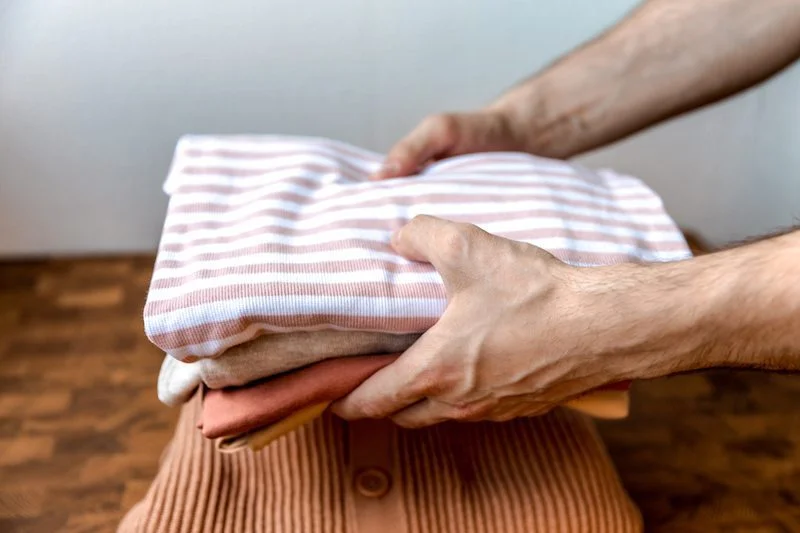4 Simple Changes to Be More Sustainable in Your Home
With the colder months approaching, it’s a great time to learn how to be more sustainable at home.
That means living in a way that doesn’t deplete or damage your personal health or resources – or the world’s. If you consider your personal resources as time, money, and energy, it sounds like a worthy pursuit, don’t you think?
Here are four shifts you can make starting today. But watch out, once this ball gets rolling, a total lifestyle transformation can occur!
4 Simple Ways to Enhance Your Life by Being More Sustainable at Home

1. Declutter Your Life
Consumerism drives a considerable amount of carbon-emitting industry and waste. In fact, it’s estimated that an average American home has 300,000 items. Over the course of a year, we make about 156 impulse buys, spending up to $5,400!
Translation? We have a lot of stuff we don’t need.

So, one drawer, cupboard, closet, or room at a time, take stock of what you have, and get rid of what you no longer use or like. Either by selling, donating, recycling, or discarding, you get to determine what you want in your life – what’s important. Getting rid of items means you’ll have less to clean, less to organize, and less stress, which can increase free space, energy, and joy!
Making an honest appraisal of your things will also make you less apt to buy stuff you don’t need in the future. It leads to less debt and more financial freedom to spend your time and energy on things or experiences that are more meaningful to you. Of course, when you buy less, your carbon footprint goes down as well. Double win!
2. Clean Green
Switch to “green” cleaning products, including laundry detergent, cleaning supplies, dishwashing soap, and dishwasher detergent. Or make your own natural cleaners using natural antiseptics and deodorizes like white vinegar and baking soda.
The unfortunate reality is that chemicals in conventional cleaners often find their way into waterways. They are flushed or rinsed from your home into the city’s wastewater and make their way to a water treatment facility, where they are mostly removed.
But this process isn’t perfect, and chemicals can get into the environment and cause great harm. A study conducted by the United States Geological Survey found persistent detergent traces in 69% of streams sampled across the United States, and 66% contained disinfectants. Alkylphenol ethoxylate, a common surfactant ingredient in cleaners, has been shown in laboratory studies to function as an endocrine disrupter, causing adverse reproductive effects of the types seen in wildlife exposed to polluted waters.
Of course, there’s your personal exposure to the chemical toxins in these cleaning products to consider, and their impact on your health.
Luckily, there are a host of green cleaning products on the market today with cleaning power that rivals chemical brands.
3. Become an Energy Saver
It’s remarkable how many simple acts you can do around your home that save energy – and money.

The world used to run on incandescent lighting (the traditional light bulb), but it’s being phased out by light-emitting diodes (LEDs), the most efficient and energy-saving light bulbs on the market. They use 75% less energy and last 25 to 30 times longer than an incandescent bulb. Also, LED bulbs are cool to the touch. Switching to LEDs will cost you more, but they’ll save you in the long run…roughly $180 a year.
Unplug
Unplug your television, kitchen appliances (toaster, juicer, coffeemaker, etc.), hair appliances, and electronics when you aren’t using them. According to the Energy Star website, these “phantom” power drains can add up to as much as 10% of a household’s electrical use. Imagine how much energy could be saved if we all unplugged these devices when not in use?
Cold Water, Hang Dry
According to the federal Department of Energy, hot water accounts for about 18% of your power bill. So, ease up on the hot water and save.
Take cooler showers. Lower your water heater thermostat several degrees. Save additional energy by washing your clothing in cold water. Also, be sure to wash full-size loads to get the most out of the water your washer requires.
If available, use the moisture detection feature on your dryer. Or better yet, hang dry your clothing and bypass the dryer altogether. It’s a method that’s worked well for centuries.
4. Waste Less Food

American homes are responsible for roughly 43% of food waste, or 27 million tons annually. A tremendous amount of energy goes into growing, making, packaging, and transporting food, so don’t be a food waster.
Be careful of unplanned purchases and supposed “bargains” (as much as 55% of food purchases are unplanned). Avoid buying in bulk; you don’t save money if you don’t eat it. And always shop with a list.
Perishables – fresh deli items, meats, fruits and vegetables, seafood, milk and dairy, and some grain products such as bread and bakery items – are the most discarded foods. Instead of buying perishables for the entire week, buy them as needed every two to three days.
Make consuming your food a game. Get creative with ingredients and see if you can prepare an inventive meal at the end of the week with the last few items you have in the fridge. Many great recipes were discovered this way! Consider starting a compost with any leftover food scraps.
Sustain Your Commitment to Live More Sustainably
Remember that small changes can make a big difference, especially if you build on them. One shift at a time in the home can truly mark the beginning of a new way of living.
At BrainMD, we’re dedicated to providing the highest purity nutrients to improve your physical health and overall well-being. For more information about our full list of brain healthy supplements, please visit us at BrainMD.
- Foodscaping: How to Grow Healthy Foods In Your Own Garden! - April 12, 2024
- Eat Your Fruits and Veggies (Don’t Drink Them) - March 29, 2024
- Some of the Best Fermented Foods for Gut Health (Recipes Included!) - March 12, 2024



